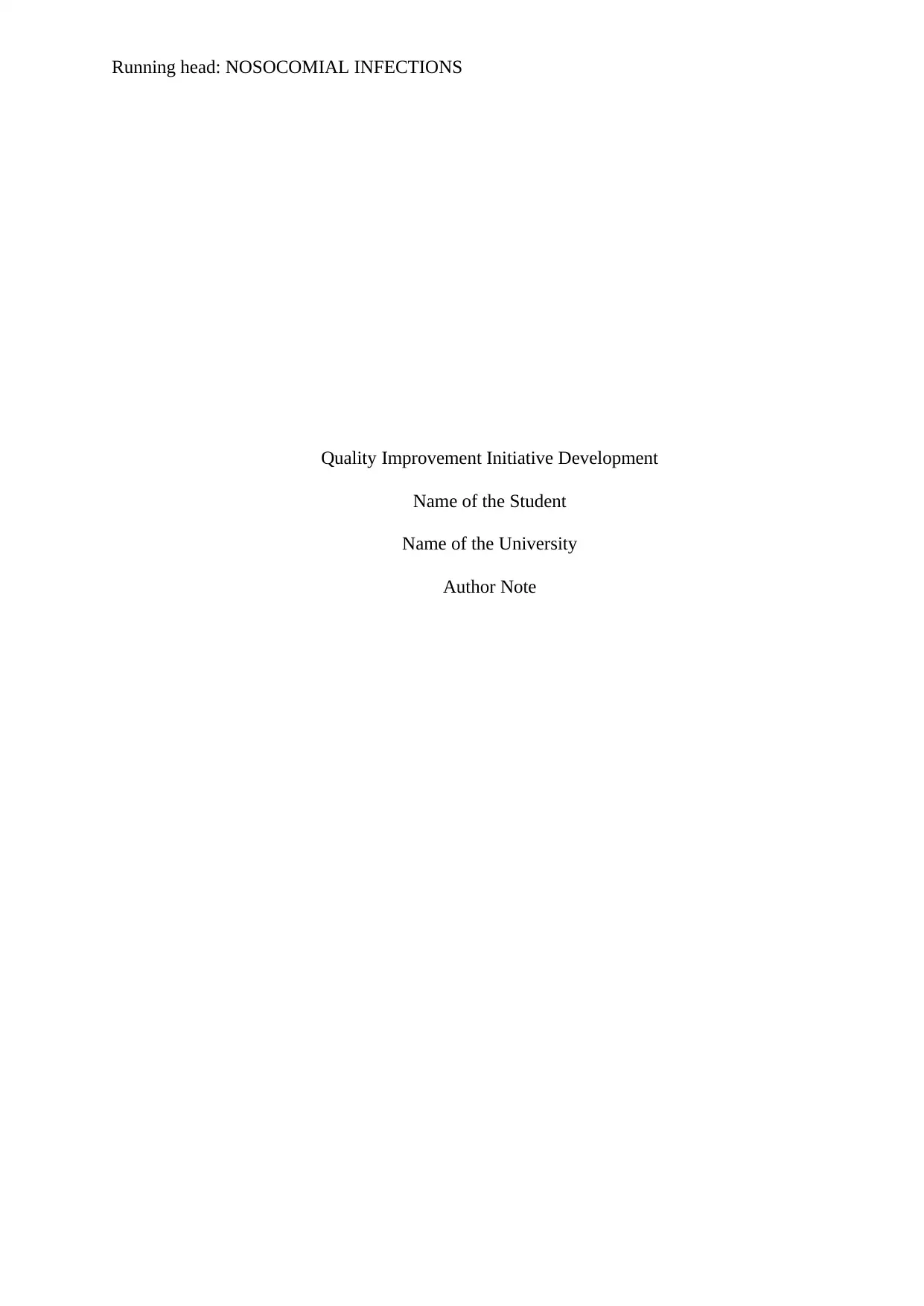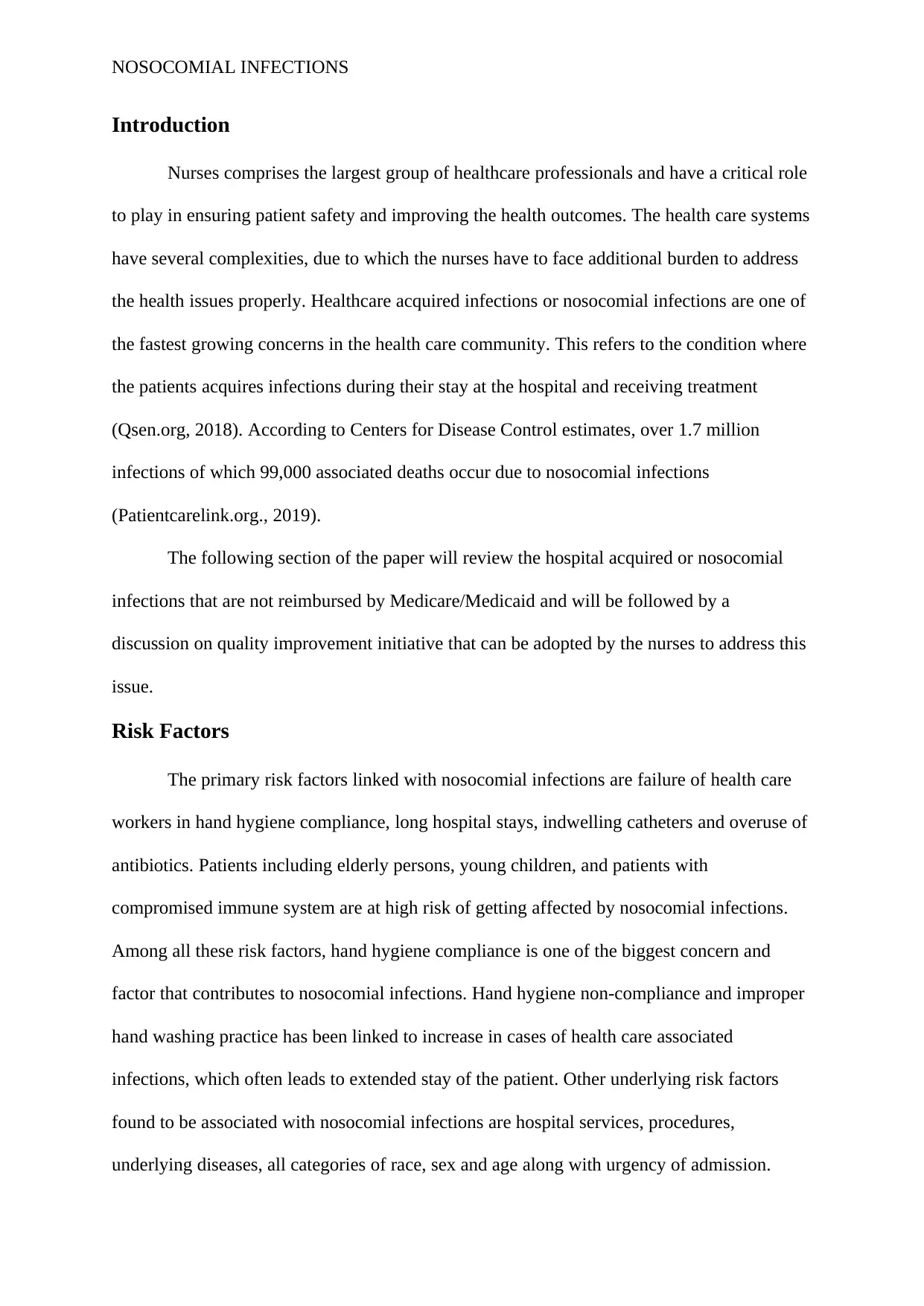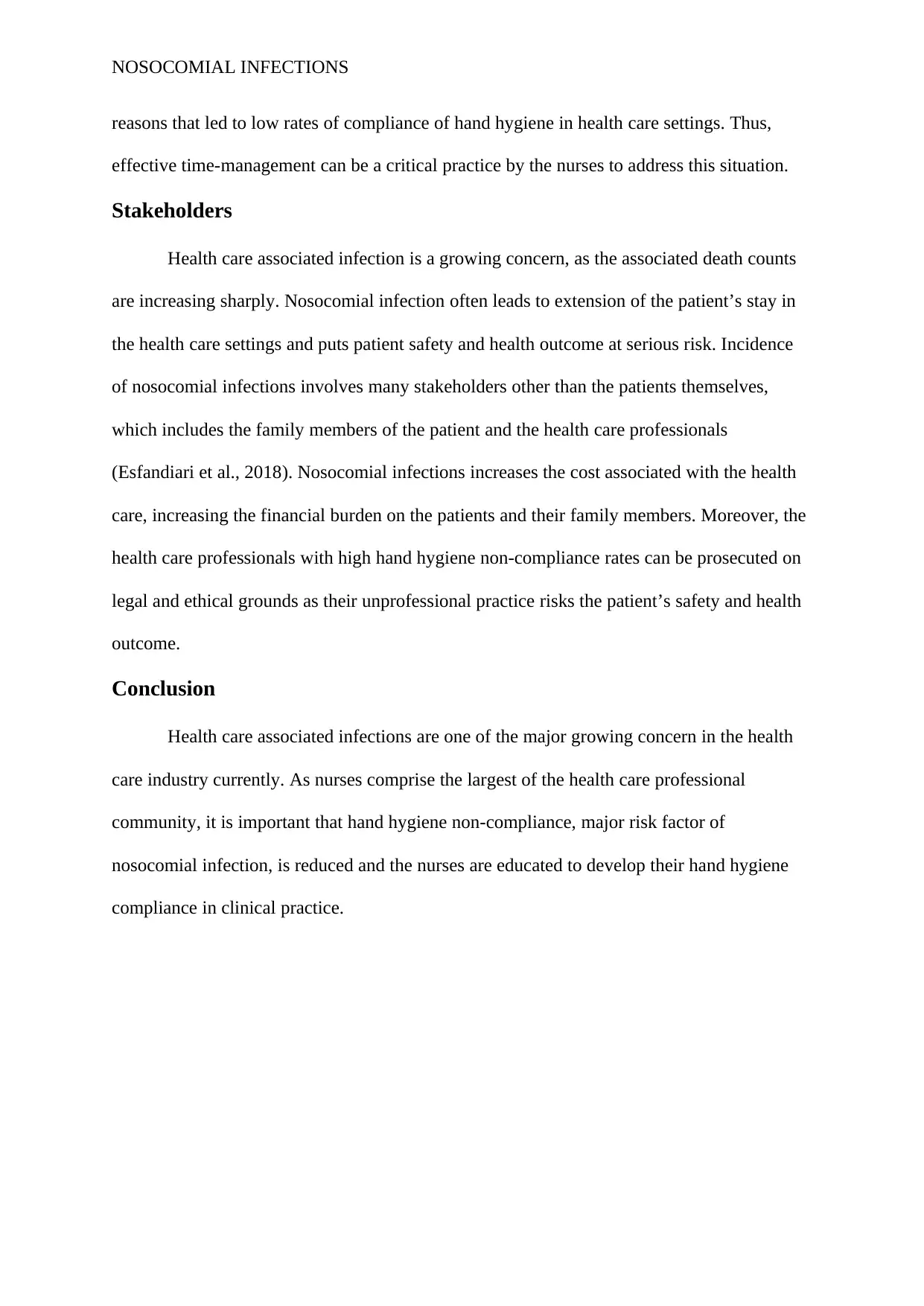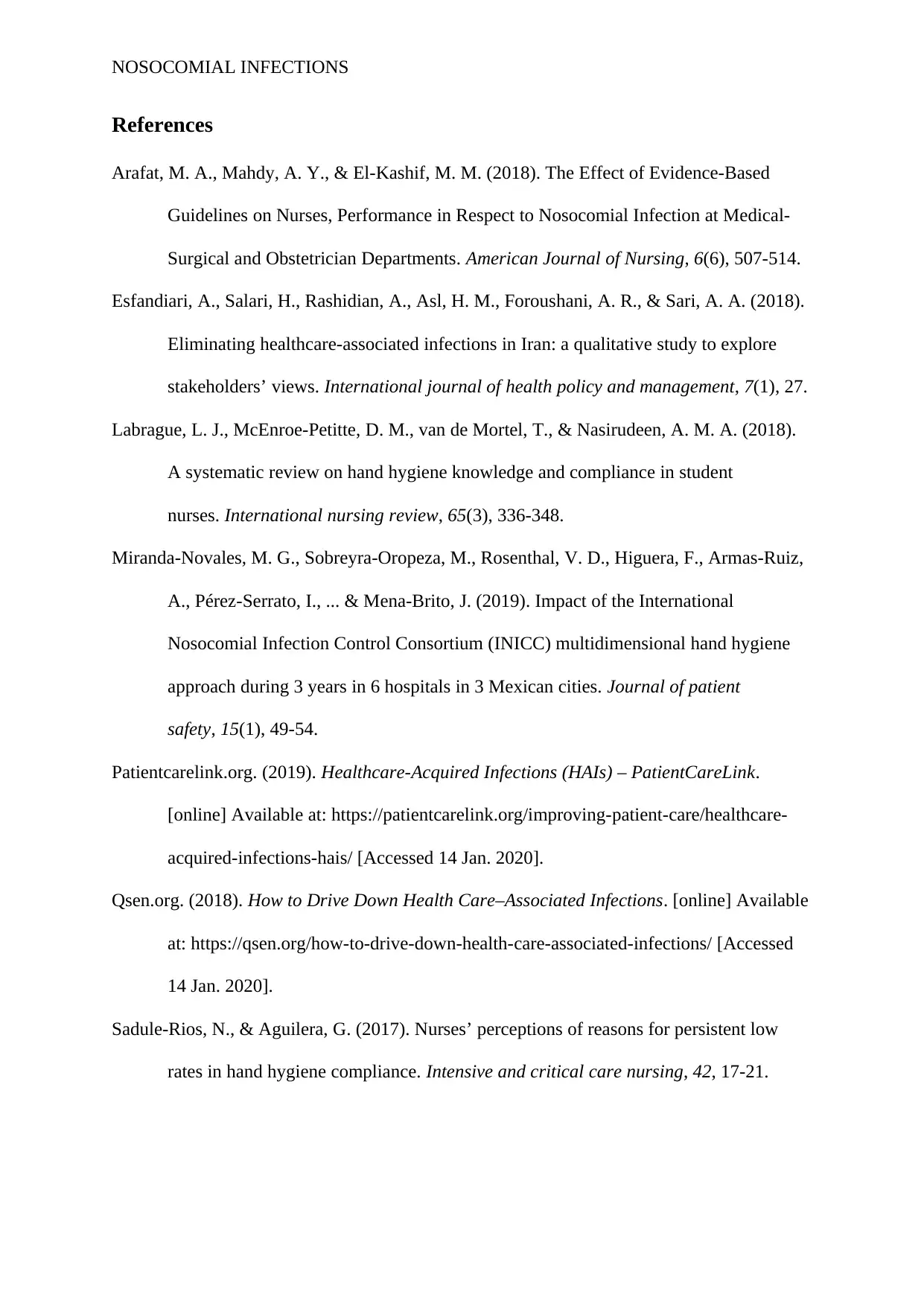Assessment 1: Quality Improvement Initiative for Nosocomial Infections
VerifiedAdded on 2022/08/26
|5
|1204
|17
Report
AI Summary
This report delves into the critical issue of nosocomial infections, also known as healthcare-acquired infections (HAIs), a significant concern in modern healthcare. It begins by defining nosocomial infections and highlighting their impact, including increased patient morbidity, mortality, and healthcare costs. The report explores the primary risk factors associated with HAIs, such as inadequate hand hygiene compliance, extended hospital stays, and the overuse of antibiotics. It then examines evidence-based solutions to mitigate these risks, emphasizing the effectiveness of multi-dimensional interventions to improve hand hygiene practices. The report underscores the crucial role of nurses in preventing HAIs, citing studies that highlight the importance of education, time management, and adherence to clinical practice guidelines. Finally, it identifies the various stakeholders involved in addressing nosocomial infections, including patients, their families, and healthcare professionals, and discusses the legal and ethical implications of non-compliance. The report concludes with a call to action for nurses to prioritize hand hygiene and contribute to improved patient safety outcomes.

Running head: NOSOCOMIAL INFECTIONS
Quality Improvement Initiative Development
Name of the Student
Name of the University
Author Note
Quality Improvement Initiative Development
Name of the Student
Name of the University
Author Note
Paraphrase This Document
Need a fresh take? Get an instant paraphrase of this document with our AI Paraphraser

NOSOCOMIAL INFECTIONS
Introduction
Nurses comprises the largest group of healthcare professionals and have a critical role
to play in ensuring patient safety and improving the health outcomes. The health care systems
have several complexities, due to which the nurses have to face additional burden to address
the health issues properly. Healthcare acquired infections or nosocomial infections are one of
the fastest growing concerns in the health care community. This refers to the condition where
the patients acquires infections during their stay at the hospital and receiving treatment
(Qsen.org, 2018). According to Centers for Disease Control estimates, over 1.7 million
infections of which 99,000 associated deaths occur due to nosocomial infections
(Patientcarelink.org., 2019).
The following section of the paper will review the hospital acquired or nosocomial
infections that are not reimbursed by Medicare/Medicaid and will be followed by a
discussion on quality improvement initiative that can be adopted by the nurses to address this
issue.
Risk Factors
The primary risk factors linked with nosocomial infections are failure of health care
workers in hand hygiene compliance, long hospital stays, indwelling catheters and overuse of
antibiotics. Patients including elderly persons, young children, and patients with
compromised immune system are at high risk of getting affected by nosocomial infections.
Among all these risk factors, hand hygiene compliance is one of the biggest concern and
factor that contributes to nosocomial infections. Hand hygiene non-compliance and improper
hand washing practice has been linked to increase in cases of health care associated
infections, which often leads to extended stay of the patient. Other underlying risk factors
found to be associated with nosocomial infections are hospital services, procedures,
underlying diseases, all categories of race, sex and age along with urgency of admission.
Introduction
Nurses comprises the largest group of healthcare professionals and have a critical role
to play in ensuring patient safety and improving the health outcomes. The health care systems
have several complexities, due to which the nurses have to face additional burden to address
the health issues properly. Healthcare acquired infections or nosocomial infections are one of
the fastest growing concerns in the health care community. This refers to the condition where
the patients acquires infections during their stay at the hospital and receiving treatment
(Qsen.org, 2018). According to Centers for Disease Control estimates, over 1.7 million
infections of which 99,000 associated deaths occur due to nosocomial infections
(Patientcarelink.org., 2019).
The following section of the paper will review the hospital acquired or nosocomial
infections that are not reimbursed by Medicare/Medicaid and will be followed by a
discussion on quality improvement initiative that can be adopted by the nurses to address this
issue.
Risk Factors
The primary risk factors linked with nosocomial infections are failure of health care
workers in hand hygiene compliance, long hospital stays, indwelling catheters and overuse of
antibiotics. Patients including elderly persons, young children, and patients with
compromised immune system are at high risk of getting affected by nosocomial infections.
Among all these risk factors, hand hygiene compliance is one of the biggest concern and
factor that contributes to nosocomial infections. Hand hygiene non-compliance and improper
hand washing practice has been linked to increase in cases of health care associated
infections, which often leads to extended stay of the patient. Other underlying risk factors
found to be associated with nosocomial infections are hospital services, procedures,
underlying diseases, all categories of race, sex and age along with urgency of admission.

NOSOCOMIAL INFECTIONS
Evidence Based Solutions
The primary focus of many researchers for years have been to increase the
compliance of hand hygiene in health care settings to reduce the incidence of nosocomial
infections. According to Miranda-Novales et al. (2019), multi-dimensional intervention to
progress hand hygiene compliance is the most suited approach. This multi-dimensional
approach includes workplace reminders, education and training on hand hygiene, ensuring
availability of supplies, process improved surveillance of hand hygiene, improving
administrative support and ensuring performance feedback.
Another study conducted by Arafat et al. (2018) was aimed at assessing the effect of
providing nurses with evidence-based guidelines on hand hygiene compliance. According to
the research findings from this study, it can be concluded that the nurses aware of evidence
based practice guidelines for hand hygiene compliance and hand washing practices reflected
significant achievement of prevention of nosocomial infection.
Role of Nurses
The nurses have an important role to play in checking the spread of health care
associated infections and reducing the incidence of nosocomial infections cases. A study
conducted by Labrague et al. (2018) reviews the role of nurses in increasing their hand
hygiene compliance by gaining sub-optimal knowledge of the clinical practice guidelines on
the issue. The findings of the study showed that greater emphasis on educating the nursing
professionals is required to enhance the hand hygiene compliance, which will lead to
significant reduction of incidences of nosocomial infections.
A study was conducted by Sadule-Rios & Aguilera (2017) to find out the perception
of nurses regarding the prevalence of low rates of hand hygiene compliance. The research
finding suggested that high workload, lack of time and understaffing were the primary
Evidence Based Solutions
The primary focus of many researchers for years have been to increase the
compliance of hand hygiene in health care settings to reduce the incidence of nosocomial
infections. According to Miranda-Novales et al. (2019), multi-dimensional intervention to
progress hand hygiene compliance is the most suited approach. This multi-dimensional
approach includes workplace reminders, education and training on hand hygiene, ensuring
availability of supplies, process improved surveillance of hand hygiene, improving
administrative support and ensuring performance feedback.
Another study conducted by Arafat et al. (2018) was aimed at assessing the effect of
providing nurses with evidence-based guidelines on hand hygiene compliance. According to
the research findings from this study, it can be concluded that the nurses aware of evidence
based practice guidelines for hand hygiene compliance and hand washing practices reflected
significant achievement of prevention of nosocomial infection.
Role of Nurses
The nurses have an important role to play in checking the spread of health care
associated infections and reducing the incidence of nosocomial infections cases. A study
conducted by Labrague et al. (2018) reviews the role of nurses in increasing their hand
hygiene compliance by gaining sub-optimal knowledge of the clinical practice guidelines on
the issue. The findings of the study showed that greater emphasis on educating the nursing
professionals is required to enhance the hand hygiene compliance, which will lead to
significant reduction of incidences of nosocomial infections.
A study was conducted by Sadule-Rios & Aguilera (2017) to find out the perception
of nurses regarding the prevalence of low rates of hand hygiene compliance. The research
finding suggested that high workload, lack of time and understaffing were the primary
⊘ This is a preview!⊘
Do you want full access?
Subscribe today to unlock all pages.

Trusted by 1+ million students worldwide

NOSOCOMIAL INFECTIONS
reasons that led to low rates of compliance of hand hygiene in health care settings. Thus,
effective time-management can be a critical practice by the nurses to address this situation.
Stakeholders
Health care associated infection is a growing concern, as the associated death counts
are increasing sharply. Nosocomial infection often leads to extension of the patient’s stay in
the health care settings and puts patient safety and health outcome at serious risk. Incidence
of nosocomial infections involves many stakeholders other than the patients themselves,
which includes the family members of the patient and the health care professionals
(Esfandiari et al., 2018). Nosocomial infections increases the cost associated with the health
care, increasing the financial burden on the patients and their family members. Moreover, the
health care professionals with high hand hygiene non-compliance rates can be prosecuted on
legal and ethical grounds as their unprofessional practice risks the patient’s safety and health
outcome.
Conclusion
Health care associated infections are one of the major growing concern in the health
care industry currently. As nurses comprise the largest of the health care professional
community, it is important that hand hygiene non-compliance, major risk factor of
nosocomial infection, is reduced and the nurses are educated to develop their hand hygiene
compliance in clinical practice.
reasons that led to low rates of compliance of hand hygiene in health care settings. Thus,
effective time-management can be a critical practice by the nurses to address this situation.
Stakeholders
Health care associated infection is a growing concern, as the associated death counts
are increasing sharply. Nosocomial infection often leads to extension of the patient’s stay in
the health care settings and puts patient safety and health outcome at serious risk. Incidence
of nosocomial infections involves many stakeholders other than the patients themselves,
which includes the family members of the patient and the health care professionals
(Esfandiari et al., 2018). Nosocomial infections increases the cost associated with the health
care, increasing the financial burden on the patients and their family members. Moreover, the
health care professionals with high hand hygiene non-compliance rates can be prosecuted on
legal and ethical grounds as their unprofessional practice risks the patient’s safety and health
outcome.
Conclusion
Health care associated infections are one of the major growing concern in the health
care industry currently. As nurses comprise the largest of the health care professional
community, it is important that hand hygiene non-compliance, major risk factor of
nosocomial infection, is reduced and the nurses are educated to develop their hand hygiene
compliance in clinical practice.
Paraphrase This Document
Need a fresh take? Get an instant paraphrase of this document with our AI Paraphraser

NOSOCOMIAL INFECTIONS
References
Arafat, M. A., Mahdy, A. Y., & El-Kashif, M. M. (2018). The Effect of Evidence-Based
Guidelines on Nurses, Performance in Respect to Nosocomial Infection at Medical-
Surgical and Obstetrician Departments. American Journal of Nursing, 6(6), 507-514.
Esfandiari, A., Salari, H., Rashidian, A., Asl, H. M., Foroushani, A. R., & Sari, A. A. (2018).
Eliminating healthcare-associated infections in Iran: a qualitative study to explore
stakeholders’ views. International journal of health policy and management, 7(1), 27.
Labrague, L. J., McEnroe‐Petitte, D. M., van de Mortel, T., & Nasirudeen, A. M. A. (2018).
A systematic review on hand hygiene knowledge and compliance in student
nurses. International nursing review, 65(3), 336-348.
Miranda-Novales, M. G., Sobreyra-Oropeza, M., Rosenthal, V. D., Higuera, F., Armas-Ruiz,
A., Pérez-Serrato, I., ... & Mena-Brito, J. (2019). Impact of the International
Nosocomial Infection Control Consortium (INICC) multidimensional hand hygiene
approach during 3 years in 6 hospitals in 3 Mexican cities. Journal of patient
safety, 15(1), 49-54.
Patientcarelink.org. (2019). Healthcare-Acquired Infections (HAIs) – PatientCareLink.
[online] Available at: https://patientcarelink.org/improving-patient-care/healthcare-
acquired-infections-hais/ [Accessed 14 Jan. 2020].
Qsen.org. (2018). How to Drive Down Health Care–Associated Infections. [online] Available
at: https://qsen.org/how-to-drive-down-health-care-associated-infections/ [Accessed
14 Jan. 2020].
Sadule-Rios, N., & Aguilera, G. (2017). Nurses’ perceptions of reasons for persistent low
rates in hand hygiene compliance. Intensive and critical care nursing, 42, 17-21.
References
Arafat, M. A., Mahdy, A. Y., & El-Kashif, M. M. (2018). The Effect of Evidence-Based
Guidelines on Nurses, Performance in Respect to Nosocomial Infection at Medical-
Surgical and Obstetrician Departments. American Journal of Nursing, 6(6), 507-514.
Esfandiari, A., Salari, H., Rashidian, A., Asl, H. M., Foroushani, A. R., & Sari, A. A. (2018).
Eliminating healthcare-associated infections in Iran: a qualitative study to explore
stakeholders’ views. International journal of health policy and management, 7(1), 27.
Labrague, L. J., McEnroe‐Petitte, D. M., van de Mortel, T., & Nasirudeen, A. M. A. (2018).
A systematic review on hand hygiene knowledge and compliance in student
nurses. International nursing review, 65(3), 336-348.
Miranda-Novales, M. G., Sobreyra-Oropeza, M., Rosenthal, V. D., Higuera, F., Armas-Ruiz,
A., Pérez-Serrato, I., ... & Mena-Brito, J. (2019). Impact of the International
Nosocomial Infection Control Consortium (INICC) multidimensional hand hygiene
approach during 3 years in 6 hospitals in 3 Mexican cities. Journal of patient
safety, 15(1), 49-54.
Patientcarelink.org. (2019). Healthcare-Acquired Infections (HAIs) – PatientCareLink.
[online] Available at: https://patientcarelink.org/improving-patient-care/healthcare-
acquired-infections-hais/ [Accessed 14 Jan. 2020].
Qsen.org. (2018). How to Drive Down Health Care–Associated Infections. [online] Available
at: https://qsen.org/how-to-drive-down-health-care-associated-infections/ [Accessed
14 Jan. 2020].
Sadule-Rios, N., & Aguilera, G. (2017). Nurses’ perceptions of reasons for persistent low
rates in hand hygiene compliance. Intensive and critical care nursing, 42, 17-21.
1 out of 5
Related Documents
Your All-in-One AI-Powered Toolkit for Academic Success.
+13062052269
info@desklib.com
Available 24*7 on WhatsApp / Email
![[object Object]](/_next/static/media/star-bottom.7253800d.svg)
Unlock your academic potential
Copyright © 2020–2025 A2Z Services. All Rights Reserved. Developed and managed by ZUCOL.





